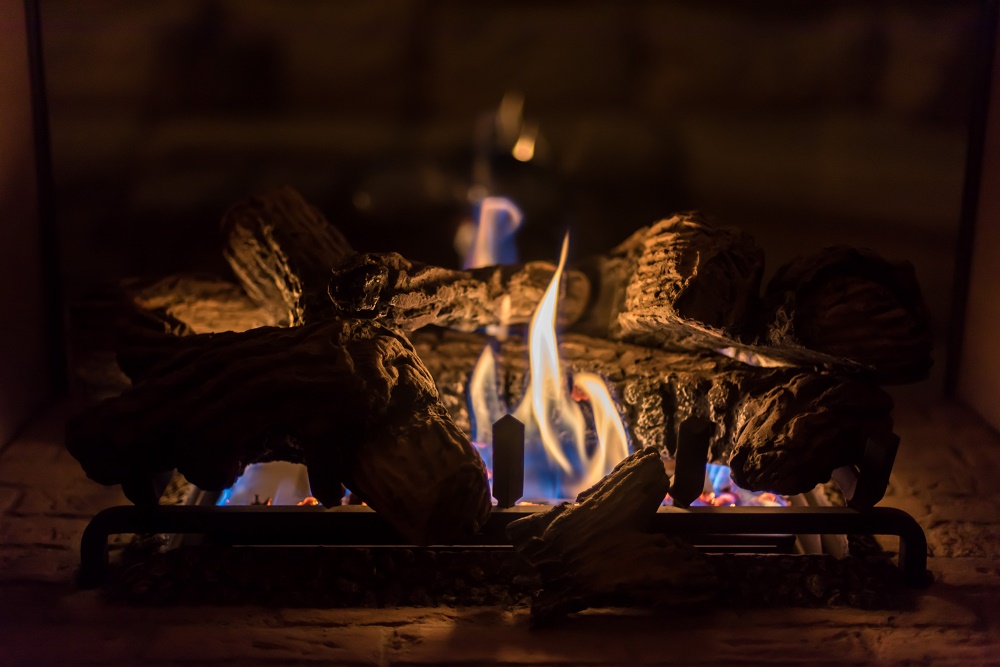Fireplaces are a great addition to any home. They provide warmth and create an ambient, welcoming environment. They’re also a major focal point of conversation when homeowners have guests over. All that being said, as awareness of environmental impact and health concerns continues to go up, many homeowners are considering fireplace conversion. This involves retrofitting traditional wood-burning fireplaces to more efficient and cleaner-burning gas options. In this blog post, we’ll explore the process of retrofitting a fireplace, converting from wood to gas logs, and the benefits of a fireplace conversion.
Read on for more information on how and why to convert, and to learn details of incentives available to homeowners through the Maricopa County Fireplace Retrofit Program.
Why Convert a Wood Fireplace to Gas?
Before diving into the retrofitting process, it’s essential to understand why more and more homeowners are converting their wood-burning fireplaces to gas. One primary reason is the increasing awareness of the environmental and health impacts associated with traditional wood-burning fireplaces.
Wood-burning fireplaces emit particles and pollutants that can negatively affect indoor and outdoor air quality. These fine particles, smaller than a human hair, can penetrate deep into the lungs, leading to respiratory issues and exacerbating heart and lung diseases. To address these concerns, many homeowners are choosing cleaner-burning alternatives, such as gas logs, to reduce their environmental footprint and enhance indoor air quality.
In the pursuit of a healthier indoor environment, gas fireplaces, especially those using natural gas logs, have emerged as a preferred option. Gas logs provide a convenient, safe, and clean-burning alternative to traditional wood-burning fireplaces. They mimic the appearance of a wood-burning fire without the associated health risks and air quality concerns.
Common Problems with Fireplaces
Wood-burning fireplaces, while charming, come with their share of issues. Some common problems include difficulty in lighting, the need for constant maintenance, and concerns about air quality. Additionally, traditional wood-burning fireplaces may not be an ideal choice for homeowners who live in areas with strict air quality regulations.
Gas Fireplaces vs. Inserts. Vs Logs
A gas fireplace is a standalone unit, offering flexibility in placement and design choices. It comes equipped with a firebox, burner, and venting system.
On the other hand, a gas insert is specifically designed to retrofit into an existing wood-burning fireplace, providing improved efficiency and modernization without a complete overhaul.
Gas logs, or log sets, are a budget-friendly option placed directly into an existing wood-burning fireplace, offering a realistic flame appearance with minimal installation costs. The choice between these options depends on factors like existing fireplace structure, budget considerations, and aesthetic preferences, allowing homeowners to find the ideal balance between convenience and traditional fireplace charm.
Convert a Wood Fireplace to Gas: Fireplace Retrofit Program
The retrofitting process is a great solution for those looking to convert a wood fireplace to gas. The Maricopa County Fireplace Retrofit Program (MCFRP) provides homeowners with the opportunity to convert their existing wood-burning fireplaces to natural gas log sets.
The program is a proactive initiative aimed at reducing air pollution from wood-burning fireplaces, improving air quality, and enhancing the health of residents.
The program encourages the installation of natural gas log sets, offering a cleaner and safer burning option. Some key benefits of the natural gas log set include:
- Convenient, Safe, and Clean Burning: Gas logs provide a hassle-free alternative with no logs to add or turn, ensuring a convenient and user-friendly experience
- Looks Like Wood Burning Fire: Enjoy the aesthetic appeal of a wood-burning fire without compromising on air quality or environmental impact.
- No Burn Day Usage: Gas log sets can be used even on No Burn Days, providing flexibility and convenience to homeowners.
- Health Effects of Wood Smoke: By choosing a gas log set, homeowners contribute to reducing the health risks associated with wood smoke particles, which can linger in the lungs for months.
Fireplace Retrofit Process
The retrofit process involves a systematic approach completed in three 30-day steps (90 days in total):
- Step 1: Obtain quotes from two gas plumbing contractors and select a contractor
- Step 2: Complete a fireplace/chimney inspection and cleaning at your own cost, ensuring the existing fireplace is safe for retrofitting. Upload the inspection receipt within the designated 30-day period.
- Step 3: Schedule the installation. The property owner will need to be present for the installation, and for an inspection if a permit is required.
Register Now
To contribute to cleaner air and a healthier indoor environment, homeowners within the program boundaries are encouraged to register for the Maricopa County Fireplace Retrofit Program. Click here to register and take the first step toward converting your wood-burning fireplace to a cleaner and more efficient natural gas log set.
Contact RP Gas Piping for All Your Gas Line Needs
If you’re interested in retrofitting a fireplace and need a gas line installed, we’re here to help. Remember: it’s essential to ensure that the installation of a gas line and the gas fireplace itself comply with local building codes and safety regulations. We have experience removing, installing, and repairing gas lines, propane tanks, and more. Our qualified gas contractors are here to help. Contact us today.
Liked this article? Here are three more!
Why You Should Never Settle for Cheap Gas Line Installation
Home Energy Saving Tips For Every Day
What is the Best Generator for Home Use?


